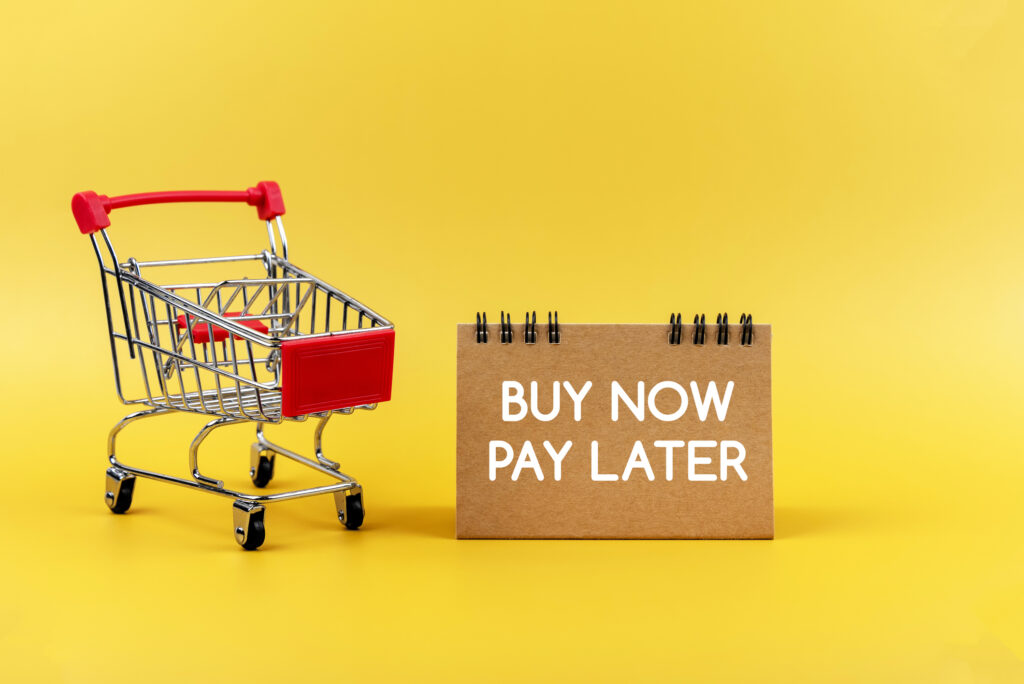Marketing is powerful, there are seemingly endless ways to spend our money, and yet… aren’t we supposed to be keeping an eye on our budgets these days? Enter BNPL.
What is BNPL?
“By now, pay later” more or less describes itself. Not to be confused with credit card borrowing, BNPL loans never progress longer than three months and are entirely interest-free. The providers function with little pack drill to get approved, and funding converges on consumer shopping with installments designed to pay all the capital back fast and seamlessly. How do the lenders earn? By charging the merchants anything from two to six percent, depending on the strength of the customer risk profile.
When the pandemic disrupted daily life, it also disrupted a whole lot of consumer trends, including triggering a trend that led to 50 million people in the US to use “buy now, pay later” (BNPL) in 2021 alone. That’s a market-shifting event no matter how one looks at it, and indeed, a financial services disruption that’s changed the order of industry dominance.
Who are the primary BNPL participants?
Curiously, it seems banks have allowed Pure Play entities (hereafter referred to as PPs) like PayPal, Zip, and Affirm to push them aside in the BNPL marketplace. That’s because it appears institutional stakeholders have been asleep at the wheel. And it’s even more mind-boggling when the next question is, “But aren’t banks in the lending business?” That is not so much the case in this vertical, it seems.
However, believing a sleeping giant will remain inactive forever is naive. Consider the insights emerging from a pivotal recent panel discussion about the advances that promise to simplify and accelerate consumers’ digital banking experiences. The contributors included the following:
- A leading fintech provider, Amount’s COO, Chris Hamilton
- Modern card issuer, Marqeta’s COO, Vidya Peters
- Mastercard (MC) Executive Vice President of Product and Engineering, North America Chiro Aikat
These participants predicted a significant bank reaction that revolves around stepping into the BNPL space in 2023 with massive initiatives. How and why? Because no matter how heroic it may seem to the layperson, you can’t blow against a hurricane through a straw. Banks and their associate companies (financial institutions, or FIs) have considerably broader and deeper data resources relating to consumer installment credit experiences than any specialist PP operator could ever hope to have.
How have banks been responding to the BNPL challenge?
How the consumers see it:
Clearly, consumers have had enough of CC debt mountains draining their resources with double-digit interest and blemishing their FICO scores. They want loans that disappear fast after a short zero-interest period—the exact opposite drivers of the conventional CC model. Thus, MC’s data reflects how easily and seamlessly BNPL facilities have hooked an overwhelming consumer majority (83%). Also, the latter not only want to see their traditional banks taking over the reins, they expect them to do so in the near future. It’s unsurprising, considering that banks traditionally spearhead consumer reliance on easing cash flow pressures in the most popular funding categories (e.g., credit cards, mortgages, and overdraft insurance). So, banks springboarding off that advantage is inevitable. That said, it’s puzzling why they’re mainly watching from the sidelines, because every day that passes gives the disruptors a more robust market foothold.
How the banks see it:
Aicat confirms that his company’s 2021 third-quarter launch of Mastercard Installments has intrigued FIs across the country as one of the first to offer an alternative to the traditional credit card (CC). MC’s right-angle turn is an admission that CC’s disadvantages (as described above) are ground zero—the core reason that BNPL got off the ground in the first place.
Everyone in the cited conference agreed that the foundational consideration for FIs is digitizing BNPL infrastructures, establishing them on a technological platform that allows sound and secure functionality. Remember also that in most cases, banks issue CCs to their customers, which means that any debt build-up is bank-funded. So, even if the banks don’t react to the usurpers directly, the CCs (as we can see with MC above) certainly will, and that automatically draws the banks into the picture. Thus, when we talk about FIs, don’t think narrowly; CC and banking powerhouses are in the same boat, albeit rowing with different oars, and we should anticipate a coordinated response. The latter is likely to be steeped in technology savvy and digitally equipped to capture the lion’s share of BNPL demand.
The banks’ response—how it’s likely to unfold
FIs have no choice—they must enter the BNPL markets to stay relevant in the credit industry. So, it’s no longer a conversation around “if they do.” It’s when they do that grabs everyone’s attention. However, as intimated above, time is of the essence, because every hour they hesitate gives PayPal and their ilk upper-hand promotional leverage. Standing still is the same as going backward, in what’s nothing short of a furious-pace environment. Instead of the sweet aroma of success, all you get is the smell of the exhaust fumes from a rampaging BNPL bandwagon with newbies at the controls.
The FIs may be chasing the disruptors on tech adaptation, but consider their excellent advantages:
- Capital infrastructures with the natural capacity to absorb BNPL operations without significant additional investment
- Fantastic risk resources and expertise
- Unmatched insights into consumer motivations in the credit arena
FIs must harness the above three advantages to resume control of an industry that’s been theirs for centuries in one format or another. The latter involves finding the delicate balance between taking the offensive and retaining brand loyalty.
The Consumer Experience Evaluation
Looking more specifically at banking advantages in BNPL activities:
- Nothing beats the bank’s overview of consumers’ financial health
- Consumers generally accept their bank’s prompts to reduce debt without undue resistance or animosity. In other words:
- FIs’ embedded image as balanced and fair professional debt collectors is not a turn-off.
- Conversely, PPs trying the same thing may well be.
Think of it this way: The digital process is a crucial factor in the BNPL experience, especially at the point of sale (POS). Nonetheless, POS considerations are only half the story—the critical differentiator rides on the lenders’ ability not to let borrowers get carried away, thus falling back into the old CC debt trap that triggered the BNPL trend in the first place. Customers rely on banks to provide funding within assessed credit capacities, structuring deals/offers that maximize their ability to borrow without creating stress and anxiety. FIs are way ahead of the curve on this aspect versus the PPs.
Strategically, FIs deploying the best banking resources must upgrade their interfaces to match the PPs’ razzle-dazzle. The latter facilitates seamless consumer movement through the point of sale with a safe and secure virtual card number or token. That’s where Amount (providing a proprietary BNPL financial stack on the backend) and Marqeta (acting as the card issuer) deliver proven and structured solutions the FIs can adopt today. Thus, it sets them up to offer their customers a quick loan application process (with an almost instant decision on BNPL credit limits) simultaneously with a virtual card number/token to buy anything, anywhere.
FIs can take BNPL to higher levels
As the FIs put their toes in the BNPL waters, they can snatch the steering wheel from the PPs and put themselves in the driver’s seat. How? By offering advances with zero interest on purchases with relatively high values and longer repayment schedules. This is one initiative the usurpers will find challenging to counteract. Why? It’ll bring brand-new verticals like autos, yachts, surgical procedures, home renovations, and more into the BNPL marketplace. Indeed, big-ticket items are knocking at the BNPL door, and it’s just a matter of time before one of the banks busts it wide open and becomes a forceful influence on the CX.
Another wide-open opportunity is for banks to engage their SMB (Small and Medium-Sized Business) clients to use their BNPL services exclusively in return for providing credit to their customers. For example, suppose Company X (an SMB entity):
- Banks with Wells Fargo (WF)
- Has WF’s secured overdrafts, mortgages, and CC facilities
- Uses WF advisors to guide its securities and finances
It’s a natural step in an integrative relationship to deploy WF as its BNPL center. On the contrary, it’s severely disappointing if the BNPL channels in WF are unavailable. Moreover, it’s an incentive for SMBs not yet into BNPL to enter it with their traditional FI financing partners holding their hands and supporting the transition. Finally, it’s reasonable to believe that a strategy of this magnitude—offering compelling consumer benefits—will receive an enthusiastic response and little, if any, resistance.
How banks (FIs) can be proactive versus reactive
- Focus on customer financial health education as part of any BNPL launch: Consumers are more open to learning about anything exciting or new. Therefore, it’s an ideal opportunity for FIs to assume the roles of “responsible funder and advisor.” By aligning credit allocations with data on customer affordability, the banks can inject balance into the BNPL process, thus attacking the propensity to overspend at its core. They are far ahead of PPs in the realm of self-regulation to give customers genuine take-home limits for what dollar amounts they can and can’t borrow.
- CCs are not going away, so the collaboration of the CC protocols with banks’ BNPL programs is a no-brainer natural fit: Banks can position themselves in the center of both, thus connecting the respective campaigns and strategies and managing the combined finances.
- Additional banking services to SMBs will result in escalated retail banking, spending, and lending volumes (i.e., revenue increases). These are the naturally flowing rewards that emerge from enhanced BNPL CXs and robust small business experiences with banks helping them to sell more.
- Bolster customer retention through personalization: We know that the most riveting CXs are those where customers feel important. Consequently, banks’ marketing teams should spread their wings to create BNPL offers in partnership with their SMB and enterprise clients. The single-minded goal should be to help build BNPL brand loyalty with customers and customers’ customers by personalizing financial leverage, thus allowing it to function at its very best. In other words, making the shopping experience more rewarding and expansive.
So, what are the banks doing right now in their BNPL strategies?
Currently, it’s a case of bits and pieces, putting a wet thumb in the air to feel wind direction and temperature. They’re coming at it from different directions, one small step at a time. As examples:
- TD Bank has tied in with NordicTrack, the fitness equipment manufacturer and distributor
- Others (such as Westpac with Afterpay and RBC with Bread’s PayPlan) come in behind the PPs, effectively funding all or part of their organizations
So, 2023 will be a pivotal year for banks powering their way into the BNPL paradigm. It revolves around building a better CX while ensuring that security and digital convenience stay aligned with creativity to keep customers engaged. Moreover, with a stellar reputation built around financial prudence, low risk, and five-star lending expertise, banks must ensure BNPL doesn’t become the rotten apple that spoils the entire barrel. No FI can afford that. Finally, FIs must deploy the resources already in their corner and their connection with CC enterprises to jet-propel their growth.
If you’re wondering how your consumers are currently using or considering Buy Now Pay Later — and whether you should get in on it, too! — now’s the perfect time to reach out to listen and learn. Need help? Let’s connect!
















